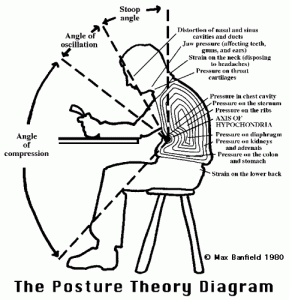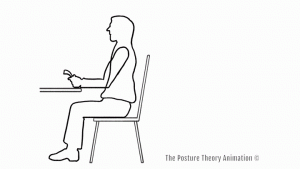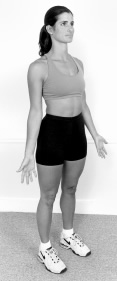By now, we should all know about the ill effects of long hours sitting at a desk, or looking down at our cell phones and other tech devices. Unfortunately, many of us have been doing this since kindergarten, and the effects of poor posture only worsen overtime.
Max Banfield, researcher and fitness expert, for many years has been advocating for changes to counteract the effects of poor posture, discussing how the angle of the body places pressure on the various structures and organs, etc. Many of the side effects of poor posture we commonly see at our wellness centre: headaches, shoulder, back and neck pain, digestive and breathing issues.

Simply fixing our posture may not always be as easy as standing at attention and rolling back our shoulders. We do have to consider the ergonomics of our work or study space, which may not always be in our control. Or there may be underlying structural issues that need to be considered. But we can do as much as possible within our circumstances. For example, set a timer for every 90 minutes, to stand up or shift your position and give yourself a quick postural check. This can be a simple scanning of your body and an adjustment, if necessary, to place your head over your heart, and your heart over your hips.

Bruegger’s postural stretch, can also easily be done sitting at your desk or while standing (known as “mountain pose” in yoga), or lying down (otherwise known as the “corpse pose” in yoga). Basically you are counteracting the inward, fetal-like desk posture by splaying the body outward:
-
Stack the vertebrae from tailbone through ribcage, to neck and head.
-
Align the head over the spine, mildly tucking in the chin.
-
Rotate the arms and hands outward, spreading the fingers.
-
Maintain a neutral pelvis. ( A neutral pelvis is when your pelvic “bowl” is neither tipping forward or backward.)
-
If standing, check your feet. Plant each corner firmly and spread out your toes. Soften your knees.
-
If lying down, place a pillow under your knees, or bend them to keep your back and pelvis neutral.
-
Pause to take a few deep breaths. Exhale fully to allow a greater intake of air during inhalation.
-
Try to maintain this pose and the slow breathing for at least 30 seconds.

See if you can incorporate this aligned posture and breath pattern while you work. If you find it difficult to take in a deep breath or exhale fully, recheck your posture to see if it is inhibiting good breathing technique.
Some other considerations for posture include the type of shoes that you wear, how you carry heavy bags or other loads, and the type of bed and pillow that you use. Consider how you are using objects: do you need to hold the phone with your shoulder? Can you place your wallet in your front pocket instead of sitting on it? Create as many opportunities for standing, moving and changing positions as possible.
Strengthening and stretching exercises also are very important to create well- balanced muscles. For example, the pectoral muscles can create a lot of imbalance in the shoulders, so focus on stretching these muscles. Conversely, the lower trapezius muscles can create a counterpoint to the pull of the pectorals, so strengthen these muscles.
The health professionals at New Leaf Wellness are here to offer any advice you need and create a plan for your postural health. Do not hesitate to ask your therapist today about your own personalized plan of action!
References:
Max Banfeld, The Posture Theory.
http://users.sa.chariot.net.au/~posture/#AnimatedPostureTheoryDiagram
Bruegger’s Exercise photo
https://miracleofmuscle.files.wordpress.com/2010/09/brueggers-relief-photo1.jpg
